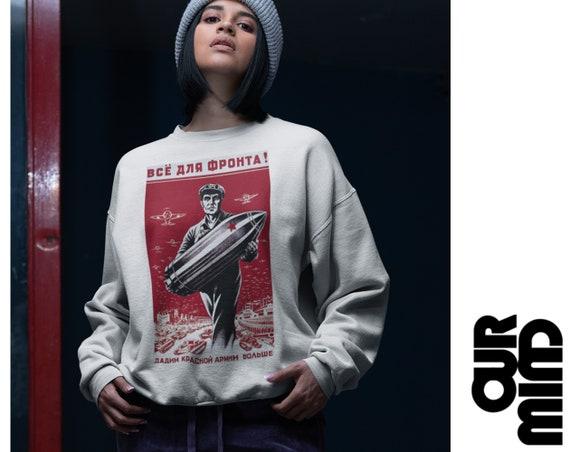In the lead-up to the high-stakes summit in Alaska, Russia has adopted an unmistakably provocative tone, using cultural symbols to underscore its messaging. The recent images of a Russian official donning a Soviet-era sweatshirt alongside the serving of the classic chicken Kyiv dish have drawn attention as deliberate acts of trolling ahead of the talks. These gestures reflect Moscow’s strategic effort to assert its identity and unsettle Western counterparts, adding an unusual cultural dimension to the geopolitical dialogue between Russia and the United States.
USSR Sweatshirt and Chicken Kyiv Symbolism in Russian Diplomacy
In the lead-up to the upcoming Alaska summit, Russian officials have embraced a series of provocative symbols that appear steeped in both nostalgia and pointed political messaging. The choice of a USSR sweatshirt worn by a key diplomat speaks volumes, evoking the cold war era’s raw display of ideological confidence. This sartorial nod to Soviet heritage is more than mere fashion-it is a calculated reminder of Russia’s enduring presence on the global stage and its resistance to Western pressure. Alongside this, the prominence of Chicken Kyiv, a dish often mistaken in the West, adds another layer of cultural signaling, subtly referencing Ukrainian identity while highlighting Moscow’s stance on the ongoing conflict.
Experts suggest these elements serve multiple functions in Russia’s diplomatic theater, blending meal and memory into a form of soft power with sharp edges. The deliberate use of Soviet-era motifs paired with culinary symbolism can be broken down into key takeaways:
- Historical Assertion: The USSR sweatshirt revives a powerful image of strength and unity that appeals to conservative and nationalist sentiments within Russia.
- Cultural Messaging: Chicken Kyiv humorously underscores Moscow’s complex relationship with Ukraine, blurring the lines between culture and conflict.
- Diplomatic Provocation: These symbols collectively act as a form of trolling aimed at Western leaders, reminding them Russia remains unpredictable.
| Symbol | Interpretation | Diplomatic Impact |
|---|---|---|
| USSR Sweatshirt | Evokes Soviet-era power and resilience | Signals defiance and historical pride |
| Chicken Kyiv | Represents cultural ties and contested identity | Provokes nuanced diplomatic messaging |
Analyzing the Impact of Russia’s Provocative Gestures Ahead of the Alaska Summit
Russia’s recent antics, ranging from public displays of vintage USSR sweatshirts to the highly charged distribution of Chicken Kyiv in diplomatic contexts, clearly aim to unsettle Western counterparts ahead of the Alaska summit. These provocations are not just symbolic but carry layers of historical and cultural significance intended to remind the US of Russia’s enduring presence and resilience on the global stage. By blending nostalgia with irony, Moscow crafts a narrative that both mocks Western policies and attempts to project strength, challenging the US to respond without escalating tensions.
Observers note that these moves fit within a broader strategy of hybrid diplomacy, where traditional negotiating tools are supplemented by psychological and cultural jabs. The impact on the summit dynamics could be measured by:
- Heightened media attention: Amplifying Russia’s voice beyond official channels.
- US response calibration: Washington must carefully navigate between firm diplomatic engagement and avoiding overreaction.
- Public perception shifts: Influencing domestic opinion on foreign policy stances toward Russia.
| Provocative Gesture | Symbolism | Potential Effect |
|---|---|---|
| USSR Sweatshirt | Echoes Soviet legacy and defiance | Challenges US narrative of Russian decline |
| Chicken Kyiv | Reference to Ukraine’s culture and conflict | Provokes sensitivity around Ukraine crisis |
| Public Displays | Demonstrates control over messaging | Exerts psychological pressure on negotiators |
Strategies for US and Allies to Address Russian Trolling in High-Stakes Negotiations
Confronting Russia’s escalating trolling tactics ahead of critical diplomatic talks necessitates a robust, multifaceted response from the US and its allies. Key measures include enhancing cyber and information defenses to quickly identify and counteract disinformation campaigns aimed at destabilizing the negotiation atmosphere. Equally vital is the cultivation of a unified communication front, ensuring that all allied voices reinforce shared objectives while exposing Kremlin provocations as strategic distractions rather than substantive dialogue. This solidarity amplifies diplomatic pressure and mitigates Moscow’s attempts to fracture coalition resolve.
Furthermore, adaptive engagement strategies can blunt Russia’s provocations. Allies are encouraged to employ:
- Pre-emptive narrative setting-controlling the framing of talks before Russian narratives gain traction;
- Real-time intelligence sharing to flag misinformation promptly;
- Targeted diplomatic signaling that differentiates the negotiation of core issues from Kremlin posturing;
- Leveraging cultural and historical savvy to anticipate and undercut trolling motifs linked to Russian identity or history.
| Strategy | Purpose | Expected Outcome |
|---|---|---|
| Unified Public Messaging | Counter Kremlin propaganda | Decreased influence of trolling |
| Intelligence Sharing | Rapidly identify disinformation | Improved response speed |
| Pre-emptive Framing | Shape negotiation narrative | Minimized disruption |
| Historical Context Awareness | Anticipate trolling themes | Enhanced preparedness |
The Conclusion
As diplomatic tensions continue to simmer ahead of the Alaska summit, Russia’s latest gestures-from the symbolic USSR sweatshirt to the provocative offering of Chicken Kyiv-underscore a strategy of calculated trolling. These moves serve not only as cultural callbacks but as pointed reminders of unresolved disputes and competing narratives. With both sides preparing for high-stakes discussions, the coming days will reveal whether such provocations deepen divisions or pave the way for candid dialogue.




